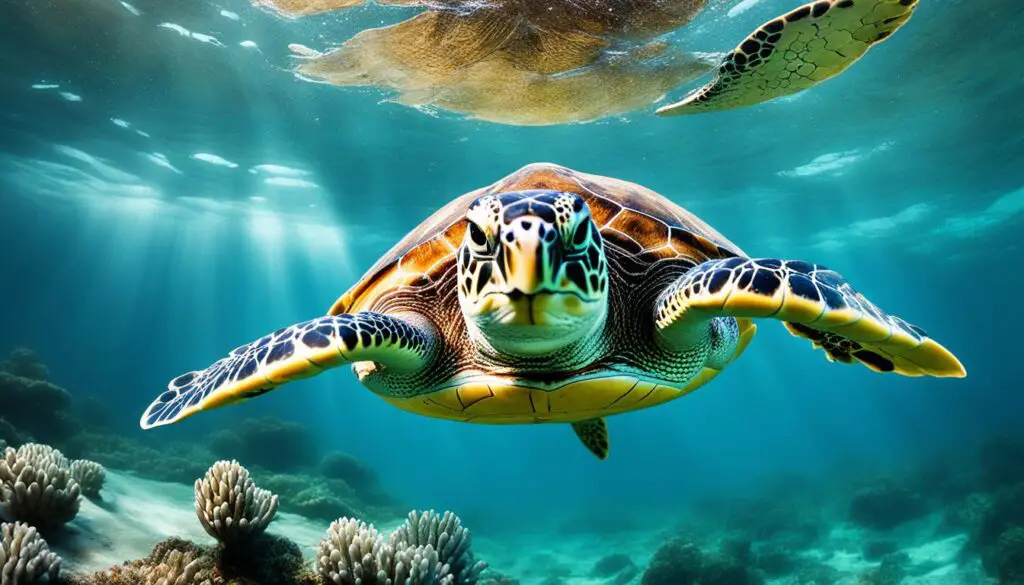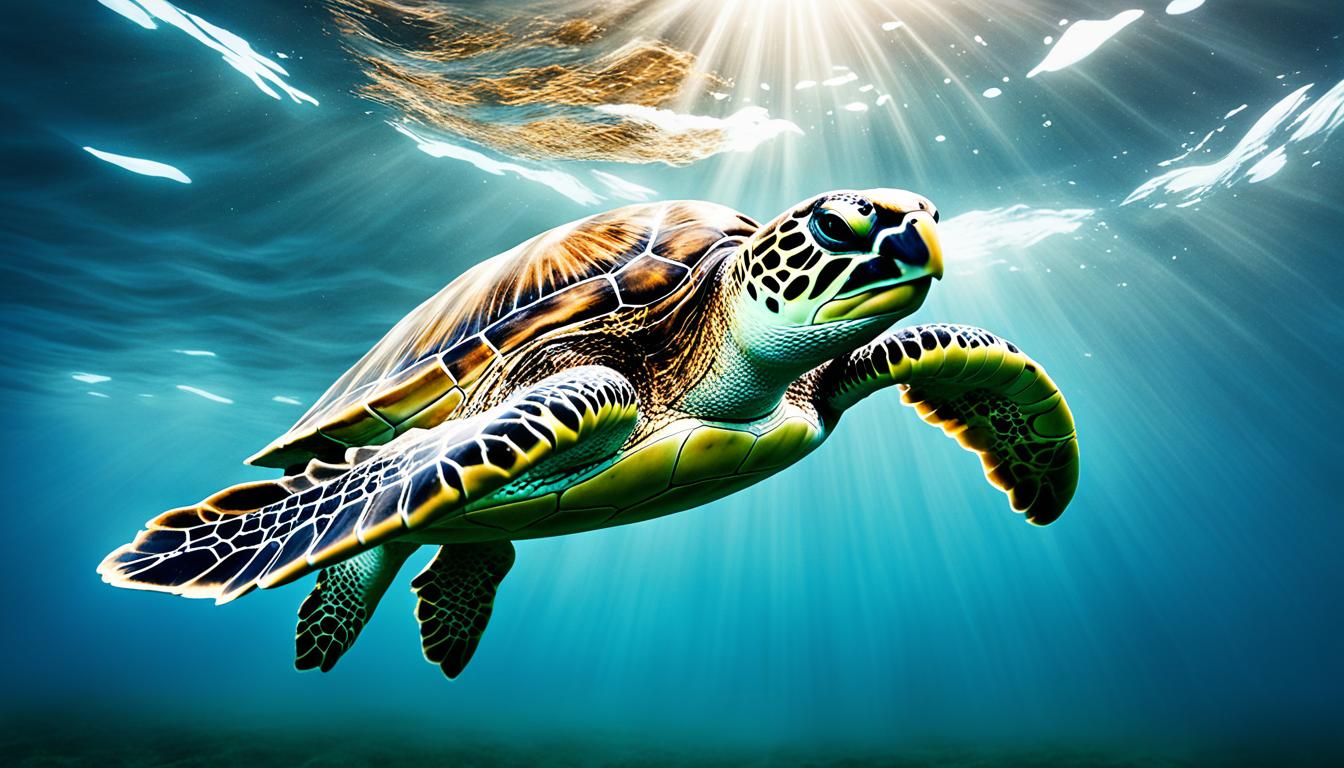Are you curious about how fast sea turtles can swim? These amazing marine reptiles have special swimming skills. They help them survive in the ocean. Sea turtles can travel long distances, whether finding food or moving across the globe.
Learning about sea turtle swimming speed helps us see their incredible journeys. It also shows us the amazing things about their biology. In this article, we will look at how fast sea turtles swim on average and their top speed. We will also see what affects their swimming.
Introduction to Sea Turtle Swimming
Sea turtles have amazing features that help them swim well in the ocean. Their bodies are shaped for speed, and their flippers are strong. This lets them move smoothly through the water. They don’t have the same limbs as freshwater turtles, which helps them swim better in the sea.
These amazing creatures live most of their lives underwater. They have special ways to survive under the sea. For example, they can hold their breath for a long time. Sometimes, they can stay underwater for 4 to 7 hours, which is really impressive.
We will learn more about the different types of sea turtles and how they swim. We’ll see how their unique traits help them in the water.
| Feature | Adaptation | Impact on Swimming |
|---|---|---|
| Body Shape | Streamlined | Reduces drag in water |
| Limbs | Fixed flippers | Allows for strong propulsion |
| Breathing | Efficient lungs | Extended time underwater |
| Shell | Streamlined carapace | Improves hydrodynamics |
Types of Sea Turtles and Their Swimming Abilities
Learning about the different sea turtles helps us appreciate their amazing swimming skills. There are seven kinds of sea turtles, each with its own special traits that affect how they swim.
- Leatherback Sea Turtle: This big turtle can dive deep and swim fast because of its flexible shell.
- Green Sea Turtle: It’s known for its strong swimming and travels long distances at a steady pace.
- Loggerhead Sea Turtle: With its big head, this turtle can swim well and move through ocean currents easily.
- Hawksbill Sea Turtle: Hawksbills are agile and can swim fast to avoid predators and move through reefs.
- Olive Ridley Sea Turtle: Found near the coast, this turtle can swim well in different marine areas.
- Flatback Sea Turtle: Living in Australian waters, this turtle has special swimming skills for shallow coastal areas.
- Kemp’s Ridley Sea Turtle: The smallest sea turtle, it has unique swimming abilities for different habitats.
Each sea turtle species has its own swimming skills that help it survive in the ocean. Watching these turtles swim shows us how they adapt and thrive in their environments. It highlights their important role in keeping the ocean healthy.
How Fast Can Sea Turtles Swim?
Sea turtles swim at speeds that tell us a lot about their lives and how they survive. They usually move at a pace of about 0.9 to 5.8 miles per hour. This speed helps us understand how they adapt to different ocean environments.
Average and Maximum Swimming Speeds
Sea turtles swim at different speeds, depending on the species. For example, green sea turtles go from 1.5 to 6.3 miles per hour. When they need to, they can speed up to 22 miles per hour to get away from danger. This fast speed helps them avoid predators.
Factors Affecting Sea Turtle Speed
Many things affect how fast sea turtles swim. These include:
- Species: Each type of sea turtle swims at its own pace.
- Environmental conditions: The temperature of the water and ocean currents change their speed.
- Body design: The size and strength of their flippers help them swim faster.
- Health status: A turtle’s health greatly affects its swimming speed and efficiency.
Leatherback sea turtles, for example, swim fast even in cold water. They have special features that let them swim well in tough conditions.
| Species | Average Swim Rate (mph) | Max Speed Burst (mph) |
|---|---|---|
| Green Sea Turtle | 1.5 – 6.3 | 22 |
| Leatherback Sea Turtle | 1.0 – 5.0 | 18 |
| Loggerhead Sea Turtle | 1.0 – 4.0 | 15 |
Adaptations for Efficient Swimming
Sea turtles have evolved special features that help them swim well. These features let them move, hunt, and avoid predators in the ocean. They are key to their survival.
Streamlined Shells and Flippers
Sea turtles have shells that cut through water, making swimming easier. Their long front flippers help them move fast. The smaller back flippers steer them with precision.
These features make them great swimmers. They can swim long distances with little effort.
Breath-Holding and Diving Techniques
Some sea turtles can hold their breath for hours. They dive for 4 to 7 hours, slowing their heart to save oxygen. Leatherbacks dive as deep as 3,000 feet.
Their flexible shells and special blood flow help them dive deep. These skills show how well they are adapted for swimming.

Comparative Swimming Speeds Among Sea Turtle Species
Looking at the swimming speeds of different sea turtle species shows some interesting differences. These differences depend on their physical traits and roles in the ocean. They help us understand how they adapt to life underwater.
Green Sea Turtles vs. Leatherback Sea Turtles
Green sea turtles and leatherback sea turtles have different swimming speeds. Green sea turtles are agile and swim at a pace of 1.5 to 6.3 mph. Leatherback sea turtles, on the other hand, can swim up to 22 mph in short bursts. These speeds are due to their unique body shapes and how they swim.
Other Species and Their Unique Abilities
There are many other sea turtle species, each with its own swimming abilities. They have speeds suited to their homes and how they survive.
- Loggerhead sea turtles: They are known for swimming long distances steadily.
- Hawksbill turtles: Their slim shells and flippers let them move quickly through coral reefs.
- Kemp’s Ridley turtles: These are the smallest and most agile, often seen in big feeding groups.
| Species | Average Speed (mph) | Maximum Speed (mph) |
|---|---|---|
| Green Sea Turtle | 1.5 – 6.3 | Unknown |
| Leatherback Sea Turtle | 2 – 5 | Up to 22 |
| Loggerhead Sea Turtle | 2 – 4 | Max 15 |
| Hawksbill Turtle | 2 – 4 | Unknown |
| Kemp’s Ridley Turtle | 1.5 – 5 | Max 22 |
These speeds show how diverse sea turtle species are. Their special adaptations help them survive and also let us explore and appreciate marine life.
Conclusion: Appreciating the Aquatic Prowess of Sea Turtles
In this article, you’ve learned about the amazing swimming skills of sea turtles. These incredible reptiles are faster and more agile than many think. They use their special body features to move through the ocean with ease.
Sea turtles are more than just fast swimmers. They play a big role in keeping the ocean healthy. They help control sea grass and algae, which keeps the marine world balanced and full of life. By learning about their importance, we can better appreciate their role in our oceans.
Thinking about the swimming skills of sea turtles makes us realize they face big challenges. We need to protect them more than ever. By caring more about sea turtles, we help protect them and the oceans they call home.










